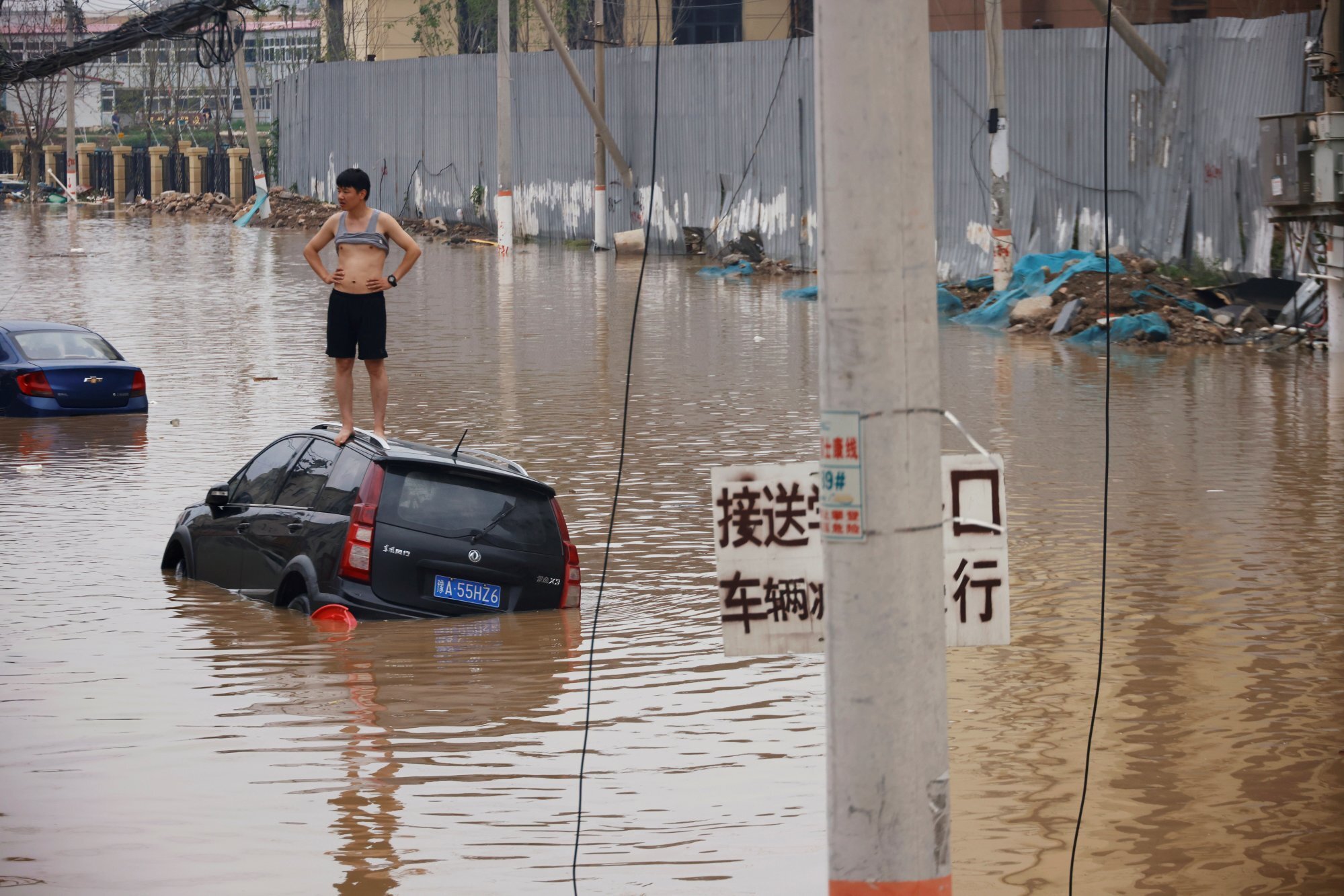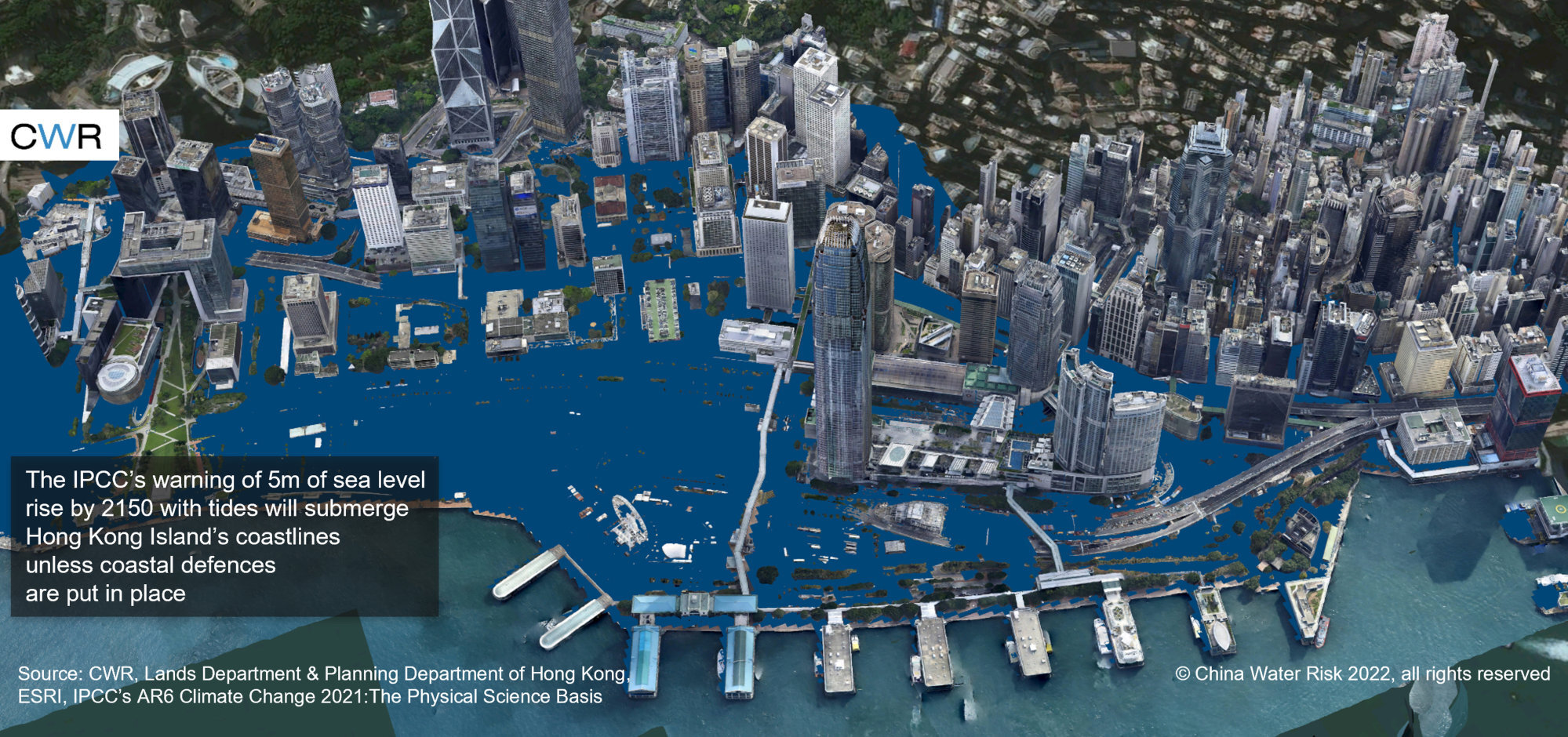
Extreme weather scorecard: Hong Kong, Macau vulnerable in Greater Bay Area as Guangzhou, Shenzhen gird for once-in-200 year storms
- The coasts of Shenzhen and Guangzhou are protected by sea walls against storm surges with the force seen once in every 100 to 200 years
- Hong Kong and Macau are less resilient against storm-surge threats from typhoons, coastal subsidence and government adaptation policies, climate advocates say
One afternoon last July, storm water crashed an underground retaining wall at Guangzhou Metro’s Shenzhou Road station, forcing the subway operator to shut Line 21 for seven hours, as a torrential downpour lashed southern China’s largest metropolis.
Guangzhou received 74.4 millimetres (3 inches) of rain within an hour that day, an unseasonably violent storm in a city that typically gets three times that precipitation over an entire month.
But what happened in Guangzhou paled in comparison with the devastation that was dumped on Zhengzhou in central China’s Henan province 10 days earlier. As much as 201.9mm of rain fell within an hour on the city on the loess plateau, setting a national high water mark since record-keeping began in 1951.

“We have no choice but to put in place no-regret adaptation against coastal threats,” said Debra Tan, founder of China Water Risk (CWR), pointing out that the latest report by a United Nations panel on climate change showed “a greater than 50 per cent chance” that the Earth’s temperature will be 1.5 degrees warmer before 2040. “It is clear that many climate impacts are irreversible, including rising seas.”
Sweltering heat in Hong Kong, extreme weather show need to act now, scientists say
“We must cut greenhouse gas emissions, but we also need to cushion the blows by picking up our efforts to adapt to climate change, which has been too weak for too long,” said Inger Andersen, executive director of the United Nations Environment Programme.
In climate change hotspots, deaths from storms, droughts and floods were 15 times higher in the past decade than in more resilient countries, Andersen said, speaking after the latest assessment report by the Intergovernmental Panel on Climate Change (IPCC) was released.
“That is only 1.1 degrees Celsius of [historical] global warming,” she said. “Even if we succeed in containing it to 1.5 degrees by the end of the century, the blows will come harder and faster. As it stands, we are heading closer to 3 degrees of warming.”

Extreme rainstorms and floods are becoming common everywhere around the world. The most recent display was in January in Australia’s New South Wales state, when 70mm of rain fell in 30 minutes in the town of Lithgow, population 13,000.
Four in every 10 of Macau’s population of 700,000 residents live less than 5 metres above sea level, as do about 10 per cent of Hong Kong’s 7.5 million people, the World Bank said.
A once-in-a-century coastal flood would become an annual occurrence at 20 to 30 per cent of global locations equipped with tide gauges to measure local sea levels.
The world’s sea level may rise by 60 centimetres by 2100, as warming seas expand in volume, while the Arctic and alpine ice sheets melt, based on the IPCC’s “best estimate” using emissions scenarios closest to the current trajectory. The possibility of a 2-metre rise in sea level by 2100 and 5 metres by 2150 in the “very high” emissions scenario “could not be ruled out” if ice sheets melt at a faster rate, the IPCC said.
Mainland China, with a 32,000-kilometre coastline from its border with North Korea to its southern boundary with Vietnam, was the 10th-most exposed out of 121 flood-prone locations worldwide, Fitch Ratings said in November.
The GBA lacks a long-term, region-wide policy to adapt to meet the challenges of climate change, partly explained by the region’s diverse vulnerabilities, where a one-size-fits-all solution is not possible, said Greenpeace East Asia’s Beijing researcher Li Zhao.
Hong Kong and Macau are less resilient than Shenzhen and Guangzhou to storm-surge threats from typhoons, coastal subsidence and government adaptation policies, CWR said in a 2020 study.
Macau’s delays to build 31km of 3.7-metre sea walls, with 5.7-metre tidal gates, exposed the city’s low-lying inner harbour to rising climate risks. In the short-term, Macau’s government will build more pumping stations to prevent floods, the territory’s Chief Executive Ho Iat-seng said in November.

By the middle of this century, 28 square kilometres of Hong Kong’s coastal region – equivalent to 147 Victoria Parks – may be pounded by storm surges, putting 100,000 residents at risk, said Greenpeace Hong Kong’s campaigner Tom Ng.
Hong Kong is vulnerable to rare but severe storms in the long term because local authorities adopted only “low and medium” climate change scenarios in designing the city’s infrastructure, CWR said. Since then, the government earmarked HK$240 billion (US$30.8 billion) towards mitigating climate risks, according to the Climate Action Plan 2050 last October.
The government should disclose the locations, the relevant works and budget to shield 26 low-lying residential areas against the rising sea level and storm surge risks, Ng said. Financial Secretary Paul Chan said in February that a budget will be allocated in the next five years.
Which locations are most vulnerable to climate change risks?
| Rankings | Extreme temperature and drought | Floods and storms | Sea level rise |
| 1 | United Arab Emirates | Mozambique | Netherlands |
| 2 | Saudi Arabia | Vietnam | Suriname |
| 3 | Qatar | Bangladesh | Maldives |
| 4 | Iraq | Philippines | Vietnam |
| 5 | Jordon | Thailand | Bahrain |
| 6 | Kuwait | Namibia | Egypt |
| 7 | Oman | Rwanda | Latvia |
| 8 | Egypt | Bolivia | Seychelles |
| 9 | Pakistan | Laos | Denmark |
| 10 | Israel | China | United Arab Emirates |
| 11 | Uzbekistan | Singapore | Qatar |
| 12 | Turkmenistan | India | Japan |
| 13 | Morocco | Indonesia | Benin |
| 14 | Australia | Colombia | Belgium |
| 15 | India | Sri Lanka | Thailand |
Source: Fitch Ratings
The Drainage Services Department is planning, designing and building improvement works such as storm water storage tanks, flood lakes, rain gardens, porous pavements and green roofs – akin to turning the city into a sponge – besides a HK$1.2 billion inter-reservoirs transfer scheme for flood protection and water conservation, according to the plan.
A working group led by the Civil Engineering and Development Department (CEDD) has studied the frequency of extreme sea levels and violent winds, and will implement improvement works at certain coastal low-lying and windy locations exposed to storm surges, a spokeswoman said.

Hong Kong’s airfield, built on reclaimed land on Chek Lap Kok island, and connected to the city via two bridges across the Ma Wan Channel, has “a high level of resilience and preparedness” against storm surge risks, the airport authority said, citing a 2020 study.
MTR Corporation, which operates the city’s subway network, said it installed flood boards at stations located in flood-prone areas.
Guangzhou will promote a flood management model dubbed the “sponge city” to cope with extreme weather, according to its 2021-2025 ecological and environment protection plan. The city will also create wind corridors to help buildings lower their summer temperatures and cut the use of air conditioners.

In nearby Shenzhen, often dubbed China’s Silicon Valley for its concentration of some of the world’s largest technology companies, the government has earmarked 1.5 billion yuan to upgrade a 13.8-km sea wall in Dapeng district, part of the defensive ring against the type of extreme storm surge seen once in every 100 to 200 years.
A nuclear power plant in eastern Shenzhen’s Daya Bay is protected by a 13-metre sea wall that can withstand a tidal level with a millennium-long return period, CWR said.
Still, policymakers and planning officials don’t fully understand the impact of climate change among China’s coastal cities, and action has been insufficient, said Xu Yijian, a researcher at the China Academy of Urban Planning and Design.
China’s carbon neutrality goal
Designs of water drainage, ports and transport infrastructure, don’t usually take climate change impact into consideration, he said in a 2020 article on climatechange.cn, a portal run by the China Meteorological Administration.
To finance long-term climate adaptation infrastructure projects such as sea walls, green bonds are a good financing tool for the government, said Nneka Chike-Obi, director of Sustainable Fitch, the sustainable finance research unit of Fitch Ratings.
“The use of proceeds from government green bonds is the most straightforward way to develop adaptation blended finance in Asia,” she said. “Governments can de-risk some elements of the project, making it more attractive for private investors to co-finance in later stages.”



